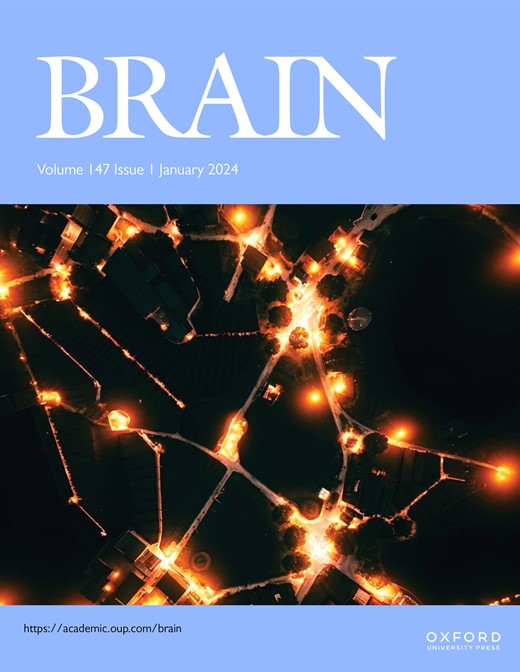克拉布病斑马鱼模型中,脑内乳糖神经酰胺的积累是GALC缺乏的特征
IF 10.6
1区 医学
Q1 CLINICAL NEUROLOGY
引用次数: 0
摘要
克拉伯病(KD)是一种常染色体隐性鞘脂病,是由于编码溶酶体β-半乳糖神经酰胺酶(GALC)的GALC基因突变引起的,GALC基因能从β-半乳糖神经酰胺、β-乳糖神经酰胺(LacCer)和神经毒性代谢物β-半乳糖神经酰胺(psychosine)中去除β-半乳糖。目前,精神素的积累被认为是脱髓鞘、神经退行性变和神经炎症的主要原因,这些是早期婴儿KD的特征,中位生存期为1.5-2年。目前,Krabbe患者的护理标准是造血干细胞移植,但只有在症状爆发前进行移植才能改善Krabbe患者的寿命。因此,需要更好地了解KD的发病机制,以开发更有效的治疗方法。这在很大程度上取决于是否有合适的新型动物模型。斑马鱼(Danio Rerio)是研究人类遗传性疾病(包括鞘脂中毒)机制和确定新疗法的有用平台。在斑马鱼中发现了人类GALC的两个同源物,分别命名为galca和galcb。在这里,我们通过CRISPR/Cas9基因组编辑为两个共同同源物中的每一个产生了突变斑马鱼系。Galcb基因敲除(KO),而不是galca基因敲除(KO),在斑马鱼胚胎和成年突变体的大脑中都能显著降低GALC的总活性。在受精后3-4个月,galcb KO斑马鱼表现出运动障碍和寿命缩短。基因表达分析、免疫组织化学、光谱共聚焦反射和透射电镜显示galcb KO突变体的大脑存在脱髓鞘、神经炎症和神经退行性变。值得注意的是,与galcb KO突变体相比,双galca/galcb KO不会导致疾病进一步恶化。最后,有针对性的脂质组学分析表明,在半乳糖KO和双半乳糖/半乳糖KO突变体的大脑中,生物活性鞘脂LacCer的显著积累伴随着精神素水平的适度增加。因此,laccer相关信号的激活发生在galcb KO动物的大脑中。此外,脑室内注射LacCer可上调5只dpf斑马鱼胚胎脑内各种促炎标志物的表达,增加mpeg1阳性巨噬细胞的浸润。总之,galcb KO斑马鱼概括了KD的几个病理特征,其特征是生物活性LacCer的积累。该模型揭示了LacCer作为KD中神经炎症/神经退行性代谢物的可能作用,对开发新的治疗策略具有重要意义。本文章由计算机程序翻译,如有差异,请以英文原文为准。
Brain accumulation of lactosylceramide characterizes GALC deficiency in a zebrafish model of Krabbe disease
Krabbe disease (KD) is an autosomal recessive sphingolipidosis due to mutations of the GALC gene encoding for the lysosomal β-galactosylceramidase (GALC) that removes β-galactose from β-galactosylceramide, β-lactosylceramide (LacCer), and the neurotoxic metabolite β-galactosylsphingosine (psychosine). At present, the accumulation of psychosine is thought to be the main cause of demyelination, neurodegeneration, and neuroinflammation that characterize the early infantile KD with a 1.5-2-year median survival. Currently, the standard of care of KD is hematopoietic stem cell transplantation which however improves the lifespan of Krabbe patients only when performed before symptoms outbreak. Thus, a better understanding of the pathogenesis of KD is required for the development of more efficacious therapeutic approaches. This largely depends upon the availability of novel suitable animal models of the disease. Zebrafish (Danio Rerio) represents a useful platform for the study of the mechanisms responsible for human hereditary diseases, including sphingolipidoses, and for the identification of new therapeutics. Two co-orthologs of human GALC have been identified in zebrafish, named galca and galcb. Here, we generated a mutant zebrafish line for each of the two co-orthologues by CRISPR/Cas9 genome editing. Galcb knockout (KO), but not galca KO, exerts a dramatic decrease of total GALC activity both in zebrafish embryos and in the brain of adult mutants. At 3-4 months post fertilization, galcb KO zebrafish showed impaired locomotion and reduced life span. Gene expression analysis, immunohistochemistry, spectral confocal reflectance, and transmission electron microscopy showed the presence of demyelination, neuroinflammation, and neurodegeneration in the brain of galcb KO mutants. Notably, double galca/galcb KO did not cause a further worsening of the disease when compared to galcb KO mutants. Finally, targeted lipidomic analysis demonstrated a dramatic accumulation of the bioactive sphingolipid LacCer in the brain of both galcb KO and double galca/galcb KO mutants with a modest increase of psychosine levels. Accordingly, activation of LacCer-related signaling occurs in the brain of galcb KO animals. Furthermore, intraventricular injection of LacCer upregulates the expression of various proinflammatory markers and increase mpeg1-positive macrophage infiltration in the brain of 5 dpf zebrafish embryos. In conclusion, galcb KO zebrafish recapitulates several pathological features of KD and is characterized by the accumulation of the bioactive LacCer. This model sheds new light on a possible role of LacCer as a neuroinflammatory/neurodegenerative metabolite in KD with implications for the development of novel therapeutic strategies.
求助全文
通过发布文献求助,成功后即可免费获取论文全文。
去求助
来源期刊

Brain
医学-临床神经学
CiteScore
20.30
自引率
4.10%
发文量
458
审稿时长
3-6 weeks
期刊介绍:
Brain, a journal focused on clinical neurology and translational neuroscience, has been publishing landmark papers since 1878. The journal aims to expand its scope by including studies that shed light on disease mechanisms and conducting innovative clinical trials for brain disorders. With a wide range of topics covered, the Editorial Board represents the international readership and diverse coverage of the journal. Accepted articles are promptly posted online, typically within a few weeks of acceptance. As of 2022, Brain holds an impressive impact factor of 14.5, according to the Journal Citation Reports.
 求助内容:
求助内容: 应助结果提醒方式:
应助结果提醒方式:


